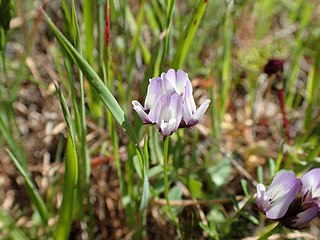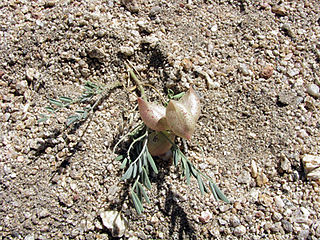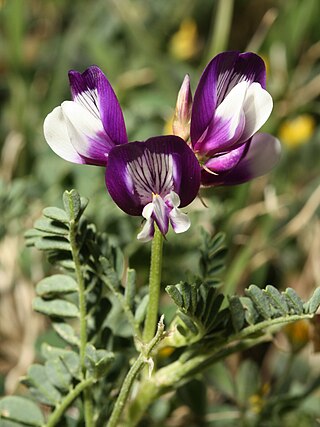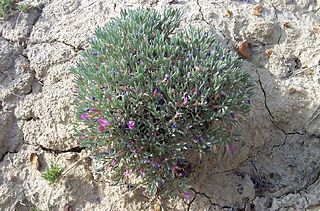
Astragalus is a large genus of over 3,000 species of herbs and small shrubs, belonging to the legume family Fabaceae and the subfamily Faboideae. It is the largest genus of plants in terms of described species. The genus is native to temperate regions of the Northern Hemisphere. Common names include milkvetch, locoweed and goat's-thorn. Some pale-flowered vetches are similar in appearance, but they are more vine-like than Astragalus.

Astragalus agnicidus is a rare species of milkvetch known by the common name Humboldt County milkvetch. It is endemic to northern California, where it is known only from two populations in Humboldt County and one in Mendocino County.

Astragalus albens is a species of milkvetch known by the common names Cushenbury milkvetch and silvery-white milkvetch.

Astragalus breweri is a species of milkvetch known by the common name Brewer's milkvetch. It is endemic to northern California, where it is found in several counties surrounding the north edge of the San Francisco Bay Area. It grows in open habitat in the North Coast Ranges, sometimes on serpentine soils.
Astragalus cimae is a species of milkvetch known by the common name Cima milkvetch. It is native to the Mojave Desert and its sky island woodlands of eastern California western Nevada, especially on calcareous soils, including the Cima Dome area in the Mojave National Preserve.
Astragalus claranus is a rare species of milkvetch known by the common names Clara Hunt's milkvetch and Napa milkvetch. It is endemic to northern California where it is known from only four or five occurrences along the border between Sonoma and Napa Counties. It is a federally listed endangered species.

Astragalus kentrophyta is a species of milkvetch known by the common name spiny milkvetch. It is native to western North America from central to west Canada, to California, to New Mexico. It grows in rocky mountainous areas, such as the Sierra Nevada, and on plateaus.

Astragalus nutans is a species of milkvetch known by the common name Providence Mountains milkvetch.

Astragalus nuttallianus is a species of milkvetch known by the common names smallflower milkvetch and turkeypeas. It is native to the southwestern and south central United States and northern Mexico, where it can be found in many types of habitat, often in dry areas.

Astragalus nuttallii is a species of milkvetch known by the common name Nuttall's milkvetch. It is native to California and Baja California, where it grows in the sandy soils of coastal habitat. This is a perennial herb forming thick, tangled clumps of hairy to hairless stems up to a meter in length. The abundant leaves are up to 17 centimeters in length and made up of many oval-shaped leaflets. The inflorescence is a large, dense body of up to 125 flowers, each around 1 to 1.5 centimeters long. The flowers are dull cream-colored and sometimes purple-tinted. The fruit is an inflated legume pod up to 6 centimeters long which dries to a papery texture and contains many seeds in its single chamber. One variety of this species, the ocean bluff milkvetch is endemic to the Central Coast of California.
Astragalus pauperculus is an uncommon species of milkvetch known by the common name depauperate milkvetch. It is endemic to northern California, where it is known from the northern Sacramento Valley and the lowest reaches of the Cascade foothills adjacent. It grows in chaparral and vernally wet grassland habitat. This is a very small annual milkvetch which grows in a delicate mat with stems no longer than 10 cm (3.9 in). The leaves are a few centimeters long and are made up of small widely spaced leaflets. The inflorescence bears two to seven flowers which are purple, sometimes with paler colored edges on their petals. Each flower is generally less than 1 cm (0.39 in) long. The fruit is a crescent-shaped legume pod between 1 and 2 cm long.

Astragalus purshii is a species of milkvetch known by the common names woollypod milkvetch and Pursh's milkvetch.

Astragalus pycnostachyus is a species of milkvetch known by the common name marsh milkvetch. It is endemic to the coastline of California, where it grows in wet saline habitat such as marshes.
Astragalus subvestitus is a species of milkvetch known by the common name Kern County milkvetch.

Astragalus desereticus is a rare species of milkvetch known by the common name Deseret milkvetch. It is endemic to Utah County, Utah, where it is known from only one population. It was thought to be extinct until 1981 when this population was discovered. The population contains 5,000 to 10,000 plants on an area of land covering less than 300 acres. It is vulnerable to damage from grazing cattle, which eat the plant and trample the soil, and from development and erosion. This is a federally listed threatened species.

Astragalus limnocharis var. montii, synonym Astragalus montii, is a rare variety of flowering plant in the legume family. It is known by the common name Monti's milkvetch. It is endemic to Utah in the United States, where there are only three known populations. Under the synonym A. montii, it is a federally listed threatened species of the United States.

Astragalus australis is a species of flowering plant in the legume family known by the common name Indian milkvetch. It is native to much of the Northern Hemisphere, including northern North America, Europe, and temperate Asia.

Astragalus barrii is a species of flowering plant in the legume family known by the common name Barr's milkvetch. It is native to the United States, where it is a "regional endemic", occurring in parts of southwestern South Dakota, northeastern Wyoming, southeastern Montana, and Nebraska.

Astragalus lentiginosus var. iodanthus, synonym Astragalus iodanthus, is a variety of Astragalus lentiginosus, a flowering plant in the legume family, Fabaceae. It is known by the common names Humboldt River milkvetch and violet milkvetch. It is native to the western United States, where its range includes California, Idaho, Nevada, Oregon, and Utah. It grows on hills and in valleys in barren sandy and volcanic soils in habitat such as sagebrush.
Astragalus tegetarioides is a species of flowering plant in the family Fabaceae, native to Oregon and northern California. It was first described by Marcus E. Jones in 1902.















